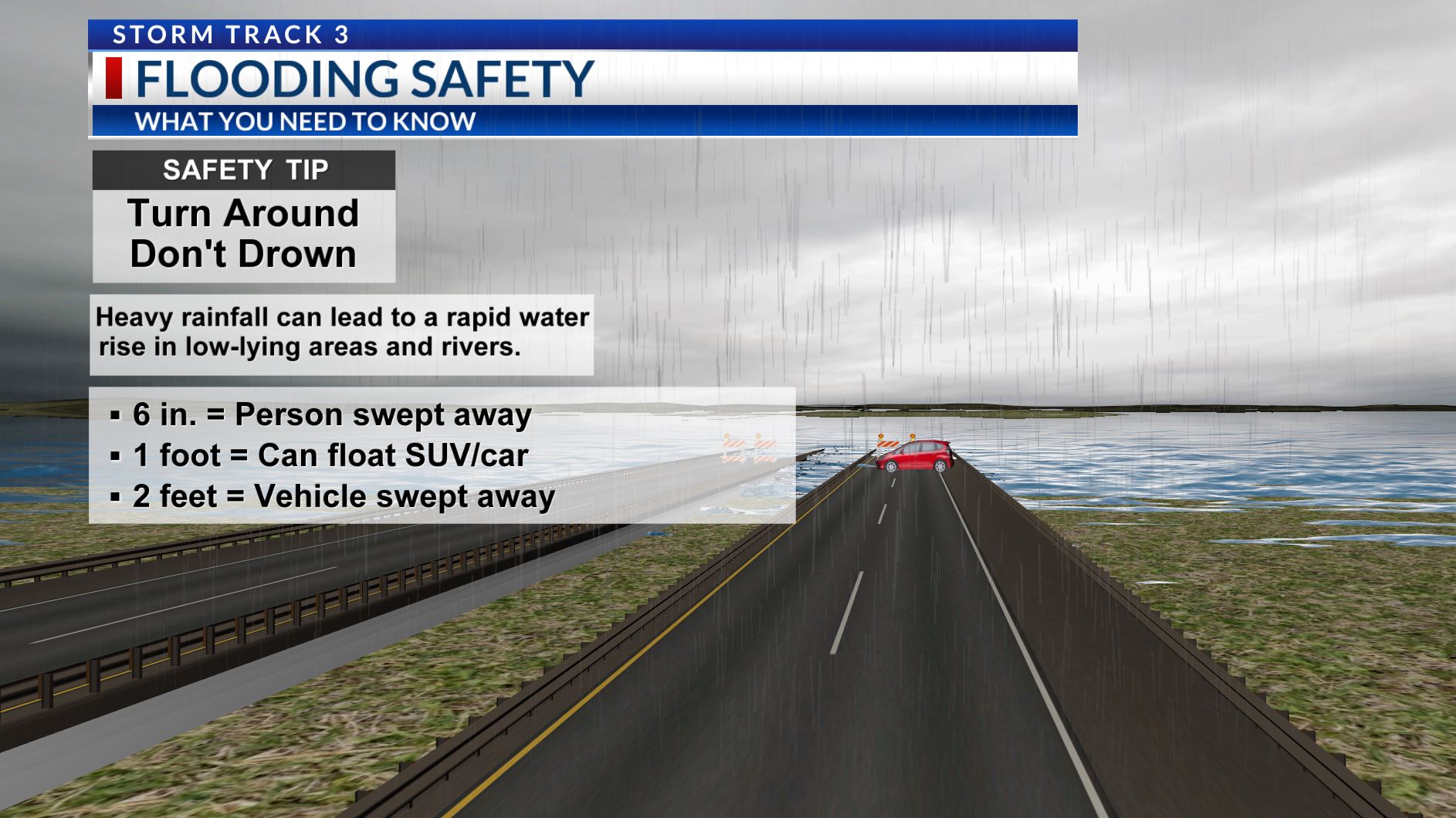Flood Alerts Explained: Types, Sources, And How To Prepare

Table of Contents
Types of Flood Alerts
Flood alerts are crucial warnings designed to give you time to react before a flood event. These alerts are categorized into different levels of severity, indicating the urgency and potential impact of the impending flood. Understanding these distinctions is vital for taking appropriate action.
-
Flood Watch: A Flood Watch means that conditions are favorable for flooding. While flooding is not imminent, it's possible. This is your time to prepare. Review your emergency plan, gather essential supplies, and monitor weather reports closely. Don't wait for a warning; prepare now. For example, a prolonged period of heavy rainfall or rapid snowmelt might trigger a Flood Watch.
-
Flood Warning: A Flood Warning is a serious alert indicating that flooding is occurring or is imminent. Immediate action is required. This is not the time to hesitate. Follow your pre-established evacuation plan, move valuables to higher ground, and if instructed, evacuate immediately. A warning might be issued when a river has exceeded its flood stage, or when significant flash flooding is observed.
-
Flood Advisory: A Flood Advisory indicates that flooding is possible within the next few hours. While the threat may be less severe than a warning, it's still important to remain vigilant, monitor the situation, and be prepared to take action if necessary. This could be triggered by localized heavy rainfall leading to potential street flooding or ponding.
It's important to note that the terminology used for flood alerts can vary slightly depending on your region. For example, some areas might use terms like "Flash Flood Warning" or "Severe Flood Warning" to denote particularly dangerous situations. Always refer to your local weather service or emergency management agency for the most accurate and up-to-date information specific to your area.
Sources of Flood Alerts
Several key organizations play a crucial role in issuing flood alerts, relying on sophisticated data collection and analysis methods. Understanding these sources can help you determine the reliability and potential limitations of the information you receive.
-
National Weather Service (NWS): The NWS is the primary source of weather-related alerts in the United States. They use a network of weather radar, river gauges, rainfall sensors, and other technologies to monitor weather patterns and predict potential flooding. They issue alerts at the national and regional levels.
-
Local Emergency Management Agencies: These agencies provide hyperlocal flood alerts tailored to specific communities. They often work in conjunction with the NWS to disseminate information and coordinate emergency response efforts. Their alerts might focus on localized flooding threats not captured in broader NWS alerts.
-
Mobile Apps and Weather Websites: Numerous mobile applications and websites (such as the FEMA app, AccuWeather, The Weather Channel) provide real-time weather information and flood alerts. These resources are convenient for receiving immediate updates and personalized warnings.
-
Community Alert Systems: Many communities utilize siren systems, text alerts, and other methods to disseminate emergency information, including flood alerts. These systems ensure rapid communication directly to residents within at-risk areas.
While these sources generally provide reliable information, it's crucial to remember that unforeseen circumstances can affect their accuracy. Always cross-reference information from multiple sources to ensure you have a complete picture of the potential flood risk in your area.
Preparing for a Flood: A Step-by-Step Guide
Proactive preparation is key to minimizing the risks and impact of flooding. This involves both short-term actions taken immediately before a flood alert and longer-term planning that builds resilience against future events.
-
Creating a Family Communication Plan: Designate an out-of-state contact person who family members can check in with. Establish a meeting point in case family members are separated during the event.
-
Developing an Evacuation Plan: Identify multiple evacuation routes and pre-determine safe destinations (friends’ homes, shelters). Practice these routes to ensure familiarity.
-
Assembling an Emergency Kit: Prepare a kit including potable water, non-perishable food, first-aid supplies, medications, important documents (in waterproof containers), flashlights, batteries, and blankets.
-
Protecting Your Property: Elevate valuable possessions, install flood barriers if feasible, and consider flood insurance. Document your belongings with photos or videos for insurance purposes.
-
Understanding Your Flood Insurance Coverage: Review your policy to understand your coverage limitations and the claims process.
Being well-informed and proactively prepared can significantly reduce the stress and damage caused by a flood.
Conclusion
This article highlighted the importance of understanding flood alerts, detailing the various types, sources, and crucial preparation steps. Being informed and proactive is essential for minimizing the risks associated with flooding. Don't underestimate the power of preparation – it's your best defense against the destructive force of a flood.
Stay safe and informed! Sign up for local flood alerts today through your local emergency management agency or a reliable weather app. Don't wait until it's too late; prepare for flood alerts and protect your family and property. Learn more about flood safety by visiting [link to relevant resource].

Featured Posts
-
 The Jenson Fw 22 Extended Collection A Comprehensive Guide
May 26, 2025
The Jenson Fw 22 Extended Collection A Comprehensive Guide
May 26, 2025 -
 Laurence Melys Une Voix Feminine Pour Le Cyclisme Sur Rtl
May 26, 2025
Laurence Melys Une Voix Feminine Pour Le Cyclisme Sur Rtl
May 26, 2025 -
 Moto Gp Inggris Panduan Lengkap Jadwal Dan Informasi Balapan
May 26, 2025
Moto Gp Inggris Panduan Lengkap Jadwal Dan Informasi Balapan
May 26, 2025 -
 Republican Deal Or Bust Trumps Aggressive Negotiating Tactic
May 26, 2025
Republican Deal Or Bust Trumps Aggressive Negotiating Tactic
May 26, 2025 -
 The New York Rangers A Changing Of The Guard
May 26, 2025
The New York Rangers A Changing Of The Guard
May 26, 2025
Latest Posts
-
 Record Breaking 202m Euromillions Jackpot Your Chance At Adele Level Wealth
May 28, 2025
Record Breaking 202m Euromillions Jackpot Your Chance At Adele Level Wealth
May 28, 2025 -
 Discover The Shop Where A Winning Lotto Ticket Was Sold
May 28, 2025
Discover The Shop Where A Winning Lotto Ticket Was Sold
May 28, 2025 -
 Euromillions Winner Could Become As Rich As Adele 202m Up For Grabs
May 28, 2025
Euromillions Winner Could Become As Rich As Adele 202m Up For Grabs
May 28, 2025 -
 Lotto Winner Still Unclaimed Winning Ticket Location Revealed
May 28, 2025
Lotto Winner Still Unclaimed Winning Ticket Location Revealed
May 28, 2025 -
 202 Million Euromillions Jackpot A Chance To Match Adeles Wealth
May 28, 2025
202 Million Euromillions Jackpot A Chance To Match Adeles Wealth
May 28, 2025
